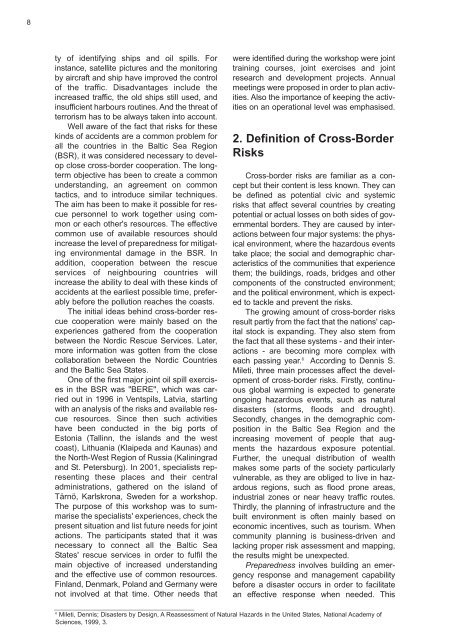Cross-Border Risks in the Baltic Sea Region: Lessons to ... - Helsinki.fi
Cross-Border Risks in the Baltic Sea Region: Lessons to ... - Helsinki.fi
Cross-Border Risks in the Baltic Sea Region: Lessons to ... - Helsinki.fi
You also want an ePaper? Increase the reach of your titles
YUMPU automatically turns print PDFs into web optimized ePapers that Google loves.
8<br />
ty of identify<strong>in</strong>g ships and oil spills. For<br />
<strong>in</strong>stance, satellite pictures and <strong>the</strong> moni<strong>to</strong>r<strong>in</strong>g<br />
by aircraft and ship have improved <strong>the</strong> control<br />
of <strong>the</strong> traf<strong>fi</strong>c. Disadvantages <strong>in</strong>clude <strong>the</strong><br />
<strong>in</strong>creased traf<strong>fi</strong>c, <strong>the</strong> old ships still used, and<br />
<strong>in</strong>suf<strong>fi</strong>cient harbours rout<strong>in</strong>es. And <strong>the</strong> threat of<br />
terrorism has <strong>to</strong> be always taken <strong>in</strong><strong>to</strong> account.<br />
Well aware of <strong>the</strong> fact that risks for <strong>the</strong>se<br />
k<strong>in</strong>ds of accidents are a common problem for<br />
all <strong>the</strong> countries <strong>in</strong> <strong>the</strong> <strong>Baltic</strong> <strong>Sea</strong> <strong>Region</strong><br />
(BSR), it was considered necessary <strong>to</strong> develop<br />
close cross-border cooperation. The longterm<br />
objective has been <strong>to</strong> create a common<br />
understand<strong>in</strong>g, an agreement on common<br />
tactics, and <strong>to</strong> <strong>in</strong>troduce similar techniques.<br />
The aim has been <strong>to</strong> make it possible for rescue<br />
personnel <strong>to</strong> work <strong>to</strong>ge<strong>the</strong>r us<strong>in</strong>g common<br />
or each o<strong>the</strong>r's resources. The effective<br />
common use of available resources should<br />
<strong>in</strong>crease <strong>the</strong> level of preparedness for mitigat<strong>in</strong>g<br />
environmental damage <strong>in</strong> <strong>the</strong> BSR. In<br />
addition, cooperation between <strong>the</strong> rescue<br />
services of neighbour<strong>in</strong>g countries will<br />
<strong>in</strong>crease <strong>the</strong> ability <strong>to</strong> deal with <strong>the</strong>se k<strong>in</strong>ds of<br />
accidents at <strong>the</strong> earliest possible time, preferably<br />
before <strong>the</strong> pollution reaches <strong>the</strong> coasts.<br />
The <strong>in</strong>itial ideas beh<strong>in</strong>d cross-border rescue<br />
cooperation were ma<strong>in</strong>ly based on <strong>the</strong><br />
experiences ga<strong>the</strong>red from <strong>the</strong> cooperation<br />
between <strong>the</strong> Nordic Rescue Services. Later,<br />
more <strong>in</strong>formation was gotten from <strong>the</strong> close<br />
collaboration between <strong>the</strong> Nordic Countries<br />
and <strong>the</strong> <strong>Baltic</strong> <strong>Sea</strong> States.<br />
One of <strong>the</strong> <strong>fi</strong>rst major jo<strong>in</strong>t oil spill exercises<br />
<strong>in</strong> <strong>the</strong> BSR was "BERE", which was carried<br />
out <strong>in</strong> 1996 <strong>in</strong> Ventspils, Latvia, start<strong>in</strong>g<br />
with an analysis of <strong>the</strong> risks and available rescue<br />
resources. S<strong>in</strong>ce <strong>the</strong>n such activities<br />
have been conducted <strong>in</strong> <strong>the</strong> big ports of<br />
Es<strong>to</strong>nia (Tall<strong>in</strong>n, <strong>the</strong> islands and <strong>the</strong> west<br />
coast), Lithuania (Klaipeda and Kaunas) and<br />
<strong>the</strong> North-West <strong>Region</strong> of Russia (Kal<strong>in</strong><strong>in</strong>grad<br />
and St. Petersburg). In 2001, specialists represent<strong>in</strong>g<br />
<strong>the</strong>se places and <strong>the</strong>ir central<br />
adm<strong>in</strong>istrations, ga<strong>the</strong>red on <strong>the</strong> island of<br />
Tärnö, Karlskrona, Sweden for a workshop.<br />
The purpose of this workshop was <strong>to</strong> summarise<br />
<strong>the</strong> specialists' experiences, check <strong>the</strong><br />
present situation and list future needs for jo<strong>in</strong>t<br />
actions. The participants stated that it was<br />
necessary <strong>to</strong> connect all <strong>the</strong> <strong>Baltic</strong> <strong>Sea</strong><br />
States' rescue services <strong>in</strong> order <strong>to</strong> ful<strong>fi</strong>l <strong>the</strong><br />
ma<strong>in</strong> objective of <strong>in</strong>creased understand<strong>in</strong>g<br />
and <strong>the</strong> effective use of common resources.<br />
F<strong>in</strong>land, Denmark, Poland and Germany were<br />
not <strong>in</strong>volved at that time. O<strong>the</strong>r needs that<br />
were identi<strong>fi</strong>ed dur<strong>in</strong>g <strong>the</strong> workshop were jo<strong>in</strong>t<br />
tra<strong>in</strong><strong>in</strong>g courses, jo<strong>in</strong>t exercises and jo<strong>in</strong>t<br />
research and development projects. Annual<br />
meet<strong>in</strong>gs were proposed <strong>in</strong> order <strong>to</strong> plan activities.<br />
Also <strong>the</strong> importance of keep<strong>in</strong>g <strong>the</strong> activities<br />
on an operational level was emphasised.<br />
2. Def<strong>in</strong>ition of <strong>Cross</strong>-<strong>Border</strong><br />
<strong>Risks</strong><br />
<strong>Cross</strong>-border risks are familiar as a concept<br />
but <strong>the</strong>ir content is less known. They can<br />
be def<strong>in</strong>ed as potential civic and systemic<br />
risks that affect several countries by creat<strong>in</strong>g<br />
potential or actual losses on both sides of governmental<br />
borders. They are caused by <strong>in</strong>teractions<br />
between four major systems: <strong>the</strong> physical<br />
environment, where <strong>the</strong> hazardous events<br />
take place; <strong>the</strong> social and demographic characteristics<br />
of <strong>the</strong> communities that experience<br />
<strong>the</strong>m; <strong>the</strong> build<strong>in</strong>gs, roads, bridges and o<strong>the</strong>r<br />
components of <strong>the</strong> constructed environment;<br />
and <strong>the</strong> political environment, which is expected<br />
<strong>to</strong> tackle and prevent <strong>the</strong> risks.<br />
The grow<strong>in</strong>g amount of cross-border risks<br />
result partly from <strong>the</strong> fact that <strong>the</strong> nations' capital<br />
s<strong>to</strong>ck is expand<strong>in</strong>g. They also stem from<br />
<strong>the</strong> fact that all <strong>the</strong>se systems - and <strong>the</strong>ir <strong>in</strong>teractions<br />
- are becom<strong>in</strong>g more complex with<br />
each pass<strong>in</strong>g year. 6 Accord<strong>in</strong>g <strong>to</strong> Dennis S.<br />
Mileti, three ma<strong>in</strong> processes affect <strong>the</strong> development<br />
of cross-border risks. Firstly, cont<strong>in</strong>uous<br />
global warm<strong>in</strong>g is expected <strong>to</strong> generate<br />
ongo<strong>in</strong>g hazardous events, such as natural<br />
disasters (s<strong>to</strong>rms, floods and drought).<br />
Secondly, changes <strong>in</strong> <strong>the</strong> demographic composition<br />
<strong>in</strong> <strong>the</strong> <strong>Baltic</strong> <strong>Sea</strong> <strong>Region</strong> and <strong>the</strong><br />
<strong>in</strong>creas<strong>in</strong>g movement of people that augments<br />
<strong>the</strong> hazardous exposure potential.<br />
Fur<strong>the</strong>r, <strong>the</strong> unequal distribution of wealth<br />
makes some parts of <strong>the</strong> society particularly<br />
vulnerable, as <strong>the</strong>y are obliged <strong>to</strong> live <strong>in</strong> hazardous<br />
regions, such as flood prone areas,<br />
<strong>in</strong>dustrial zones or near heavy traf<strong>fi</strong>c routes.<br />
Thirdly, <strong>the</strong> plann<strong>in</strong>g of <strong>in</strong>frastructure and <strong>the</strong><br />
built environment is often ma<strong>in</strong>ly based on<br />
economic <strong>in</strong>centives, such as <strong>to</strong>urism. When<br />
community plann<strong>in</strong>g is bus<strong>in</strong>ess-driven and<br />
lack<strong>in</strong>g proper risk assessment and mapp<strong>in</strong>g,<br />
<strong>the</strong> results might be unexpected.<br />
Preparedness <strong>in</strong>volves build<strong>in</strong>g an emergency<br />
response and management capability<br />
before a disaster occurs <strong>in</strong> order <strong>to</strong> facilitate<br />
an effective response when needed. This<br />
6<br />
Mileti, Dennis; Disasters by Design, A Reassessment of Natural Hazards <strong>in</strong> <strong>the</strong> United States, National Academy of<br />
Sciences, 1999, 3.
















